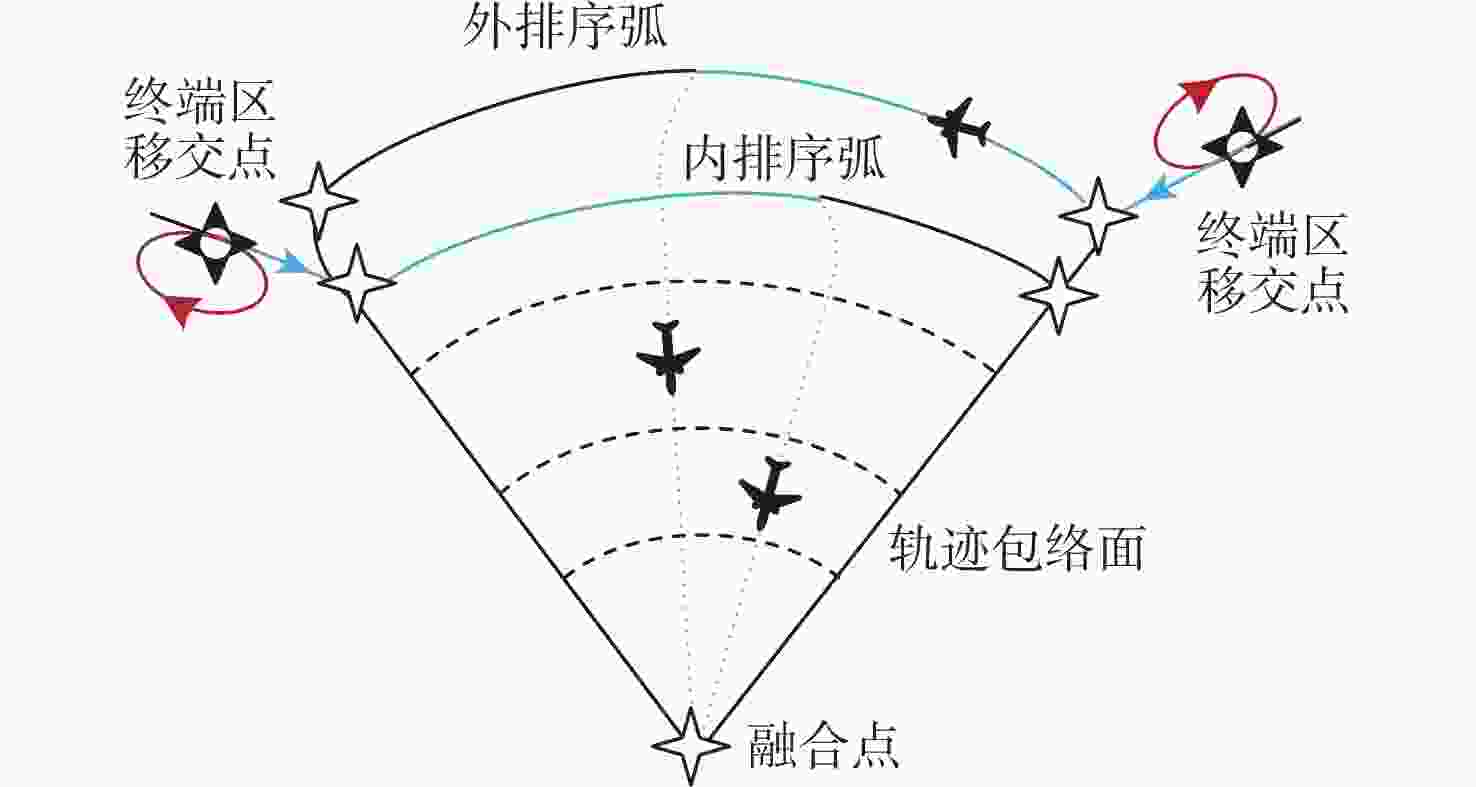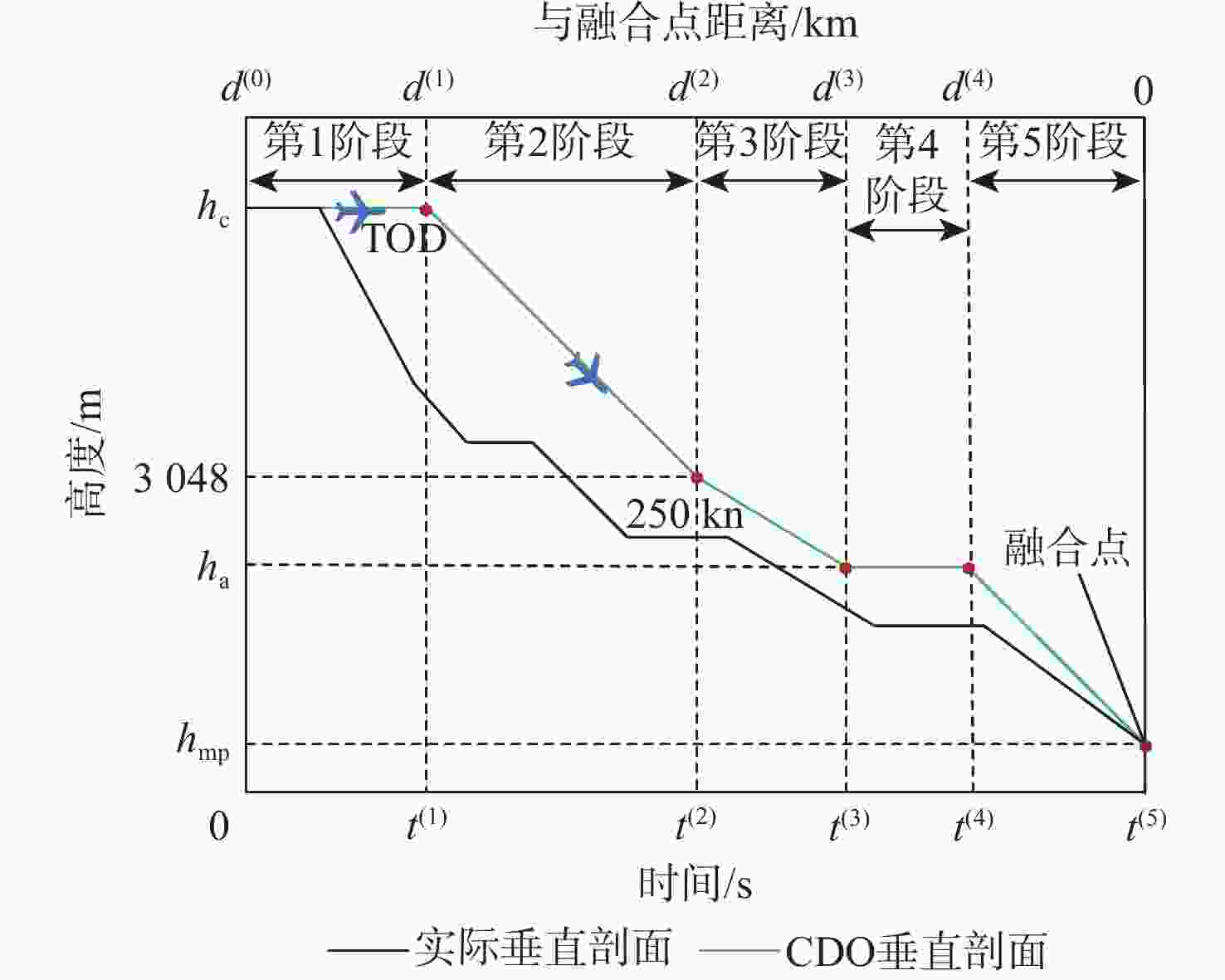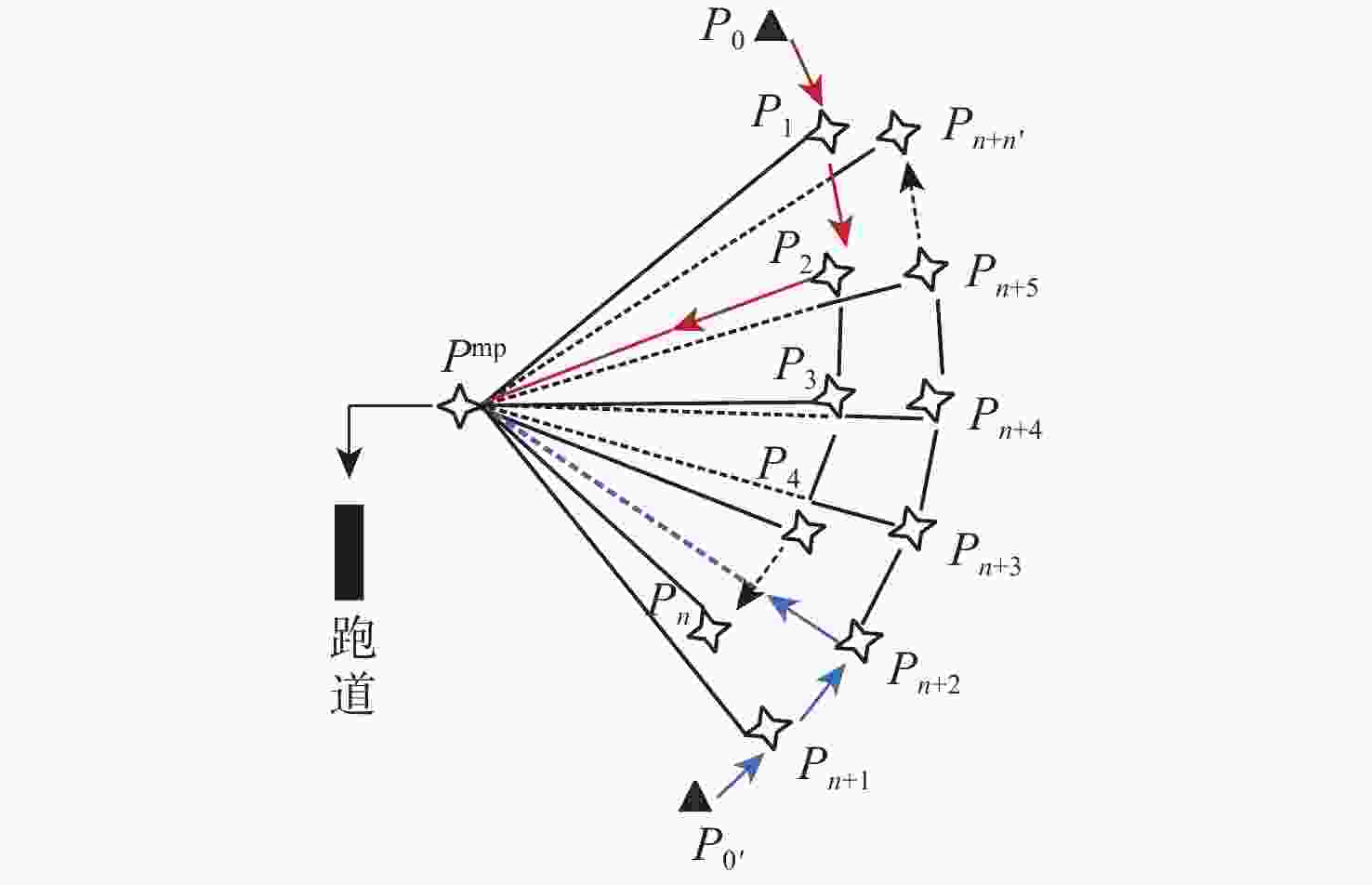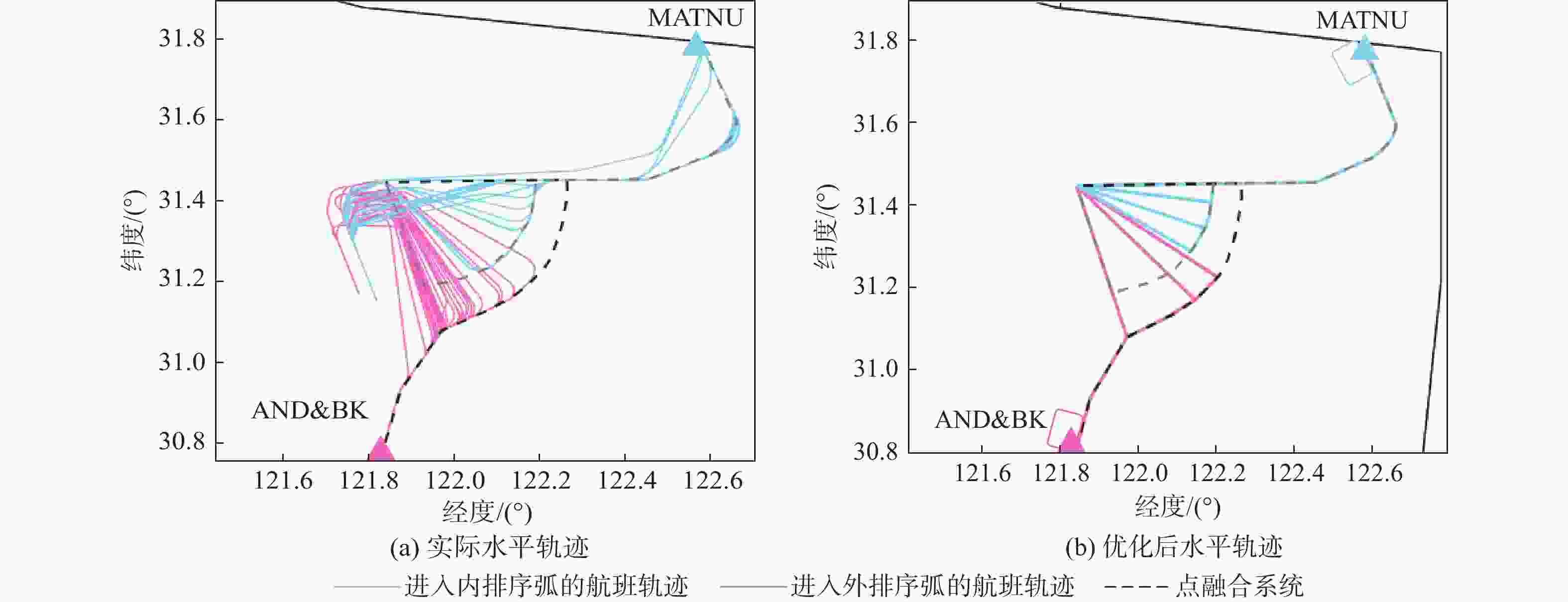Multi-aircraft low-carbon trajectories cooperative planning for point merge operation
-
摘要:
为解决在高交通密度终端区实施连续下降运行(CDO)的技术难题,提出一种面向点融合系统(PMS)的多航空器低碳轨迹协同规划方法。分析了基于管制员人工决策的点融合运行的额外碳排放产生机理;以个体航空器低碳4D轨迹为研究对象,建立了一种考虑PMS平飞弧段的CDO多阶段最优控制模型;以总体运行时间最小为目标,考虑进场交通流冲突约束,建立了多航空器CDO 4D轨迹协同规划模型。以实际PMS及航迹数据为例开展验证实验,结果表明:所提方法共减少12.2%的空中飞行时间,降低15.7%的燃油消耗和CO2排放,不仅能给出支持高效运行的航空器排序结果,还能提供达成该排序的可行低碳4D轨迹。
Abstract:In order to solve the technical problem of continuous descent operation (CDO) in the high traffic density terminal control area, a multi-aircraft low-carbon trajectory collaborative planning method for a point merge system (PMS) is proposed. Firstly, the mechanism of additional carbon emission based on the artificial decision-making of the air traffic controller was analyzed. Secondly, a multi-stage optimal control model of CDO was developed, taking into account the level flight arc segment of the PMS, using the low-carbon 4D trajectory of a single aircraft as the research object. Then, with the objective of minimum overall operation time, the 4D trajectory collaborative optimization model of multiple aircraft CDO was established with considering the arrival traffic flows’ flight conflict constraint. Finally, the validation experiment was carried out with the real PMS and its air traffic track data. In addition to providing the aircraft landing sequence that supports efficient operation, the experimental findings demonstrate that this method reduces the overall flight duration by 12.2% and CO2 emissions by 15.7%. It also provides plausible low-carbon 4D paths to accomplish this landing sequencing.
-
表 1 实际与优化后CO2排放和飞行时间
Table 1. Actual and optimized CO2 emissions and flight time
航线 飞行时间/s 燃油消耗/kg CO2排放/kg 实际航线 1 835 249.14 784.79 j=6 1350 162.72 512.50 j=7 1440 177.02 557.61 j=8 1530 191.32 602.66 j=9 1620 205.62 647.70 j=10 1710 219.92 692.75 j=11 1800 234.22 737.79 表 2 28个航班初始信息
Table 2. Initial conditions of 28 flights
航空器编号i 机型 进场方向 进场
时刻进场
高度/m进场
速度/kn航空器编号i 机型 进场方向 进场
时刻进场
高度/m进场
速度/kn1 A321 MATNU 11:01 4800 250 15 A321 AND&BK 11:58 7200 310 2 B737 MATNU 11:07 4800 270 16 A319 AND&BK 12:00 7500 300 3 A320 AND&BK 11:07 7500 280 17 A321 AND&BK 12:01 7500 300 4 B787 MATNU 11:08 5100 260 18 A319 MATNU 12:02 5400 300 5 A330 MATNU 11:17 5400 300 19 A320 AND&BK 12:10 6900 300 6 A330 AND&BK 11:19 7200 320 20 A321 AND&BK 12:15 6900 260 7 B777 AND&BK 11:20 6000 270 21 B737 MATNU 12:22 5400 260 8 A320 AND&BK 11:36 6600 260 22 B737 AND&BK 12:27 7200 300 9 A321 AND&BK 11:38 6900 280 23 A330 MATNU 12:31 5100 270 10 A320 AND&BK 11:38 7500 320 24 A320 MATNU 12:43 5400 280 11 A321 AND&BK 11:48 7200 310 25 A320 MATNU 12:46 5100 300 12 B787 MATNU 11:48 4800 260 26 A321 MATNU 12:55 5100 240 13 B737 AND&BK 11:50 6600 270 27 A320 MATNU 12:59 5400 290 14 A320 MATNU 11:55 5100 240 28 A320 AND&BK 13:00 7200 320 -
[1] ICAO. Continuous descent operations (CDO) manual: Doc 9931[S]. Montréal: ICAO, 2010: 21-36. [2] PARK S G, CLARKE J P. Optimal control based vertical trajectory determination for continuous descent arrival procedures[J]. Journal of Aircraft, 2015, 52(5): 1469-1480. doi: 10.2514/1.C032967 [3] DE OLIVEIRA R F, BÜSKENS D C. Benefits of optimal flight planning on noise and emissions abatement at the Frankfurt Airport: AIAA 2012-4482[R]. Reston: AIAA, 2012. [4] ELLERBROEK J, INAAD M, HOEKSTRA J. Fuel and emission benefits for continuous descent approaches at schiphol[C]//Proceedings of the International Conference on Research in Air Transportation. Nice: ICRAT, 2018: 2-9. [5] SOLAK S, CHEN H. Optimal metering point configurations for optimized profile descent based arrival operations at airports[J]. Transportation Science, 2018, 52(1): 150-170. doi: 10.1287/trsc.2017.0788 [6] PAWEŁEK A, LICHOTA P, DALMAU R, et al. Fuel-efficient trajectories traffic synchronization[J]. Journal of Aircraft, 2019, 56(2): 481-492. doi: 10.2514/1.C034730 [7] 吕波, 王超. 改进的扩展卡尔曼滤波在航空器4D航迹预测算法中的应用[J]. 计算机应用, 2021, 41(增刊1): 277-282.LU B, WANG C. Application of improved extended Kalman filtering in aircraft 4D trajectory prediction algorithm[J]. Journal of Computer Applications, 2021, 41(Sup 1): 277-282(in Chinese). [8] TORATANI D. Application of merging optimization to an arrival manager algorithm considering trajectory-based operations[J]. Transportation Research Part C: Emerging Technologies, 2019, 109: 40-59. doi: 10.1016/j.trc.2019.09.015 [9] DAHLBERG J, GRANBERG T A, POLISHCHUK T, et al. Capacity-driven automatic design of dynamic aircraft arrival routes[C]//Proceedings of the IEEE/AIAA 37th Digital Avionics Systems Conference. Piscataway: IEEE Press, 2018: 1-9. [10] GUI D D, LE M L, HUANG Z C, et al. Optimal aircraft arrival scheduling with continuous descent operations in busy terminal maneuvering areas[J]. Journal of Air Transport Management, 2023, 107: 102344. doi: 10.1016/j.jairtraman.2022.102344 [11] SÁEZ R, PRATS X, POLISHCHUK T, et al. Traffic synchronization in terminal airspace to enable continuous descent operations in trombone sequencing and merging procedures: an implementation study for Frankfurt Airport[J]. Transportation Research Part C: Emerging Technologies, 2020, 121: 102875. doi: 10.1016/j.trc.2020.102875 [12] SÁEZ R, POLISHCHUK T, SCHMIDT C, et al. Automated sequencing and merging with dynamic aircraft arrival routes and speed management for continuous descent operations[J]. Transportation Research Part C: Emerging Technologies, 2021, 132: 103402. doi: 10.1016/j.trc.2021.103402 [13] LIANG M, DELAHAYE D, MARÉCHAL P. Integrated sequencing and merging aircraft to parallel runways with automated conflict resolution and advanced avionics capabilities[J]. Transportation Research Part C: Emerging Technologies, 2017, 85: 268-291. doi: 10.1016/j.trc.2017.09.012 [14] 张军峰, 游录宝, 周铭, 等. 基于点融合系统的多目标进场排序与调度[J]. 北京麻豆精品秘 国产传媒学报, 2023, 49(1): 66-73.ZHANG J F, YOU L B, ZHOU M, et al. Multi-objective arrival sequencing and scheduling based on point merge system[J]. Journal of Beijing University of Aeronautics and Astronautics, 2023, 49(1): 66-73(in Chinese). [15] 杨磊, 李文博, 刘芳子, 等. 柔性空域结构下连续下降航迹多目标优化[J]. 航空学报, 2021, 42(2): 324157.YANG L, LI W B, LIU F Z, et al. Multi-objective optimization of continuous descending trajectories in flexible airspace[J]. Acta Aeronautica et Astronautica Sinica, 2021, 42(2): 324157(in Chinese). [16] ICAO. Carbon emissions calculator methodology: Version 11[S]. Montréal: ICAO, 2014: 6-7. [17] EUROCONTROL. User manual for the base of aircraft data (BADA): Revision 3.6[S]. Belgium: EUROCONTROL Experimental Centre, 2004: 6-33. [18] ICAO. Manual on airspace planning methodology for the determination of separation minima: Doc 9689-AN/953[S]. Montréal: ICAO, 1998: 55-60. -







 下载:
下载:











